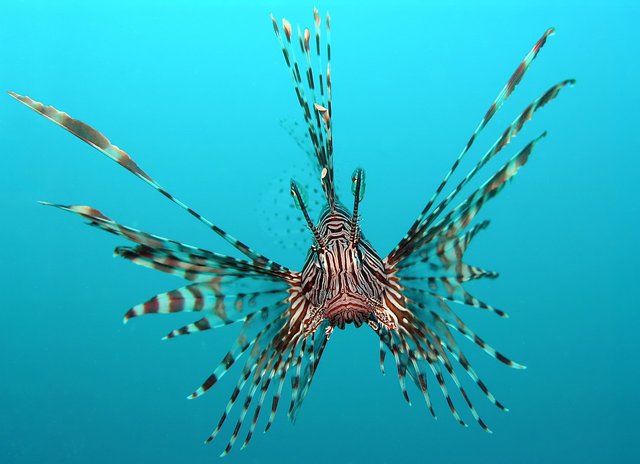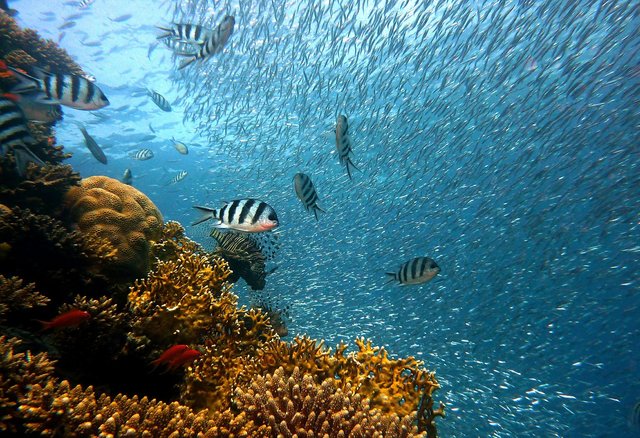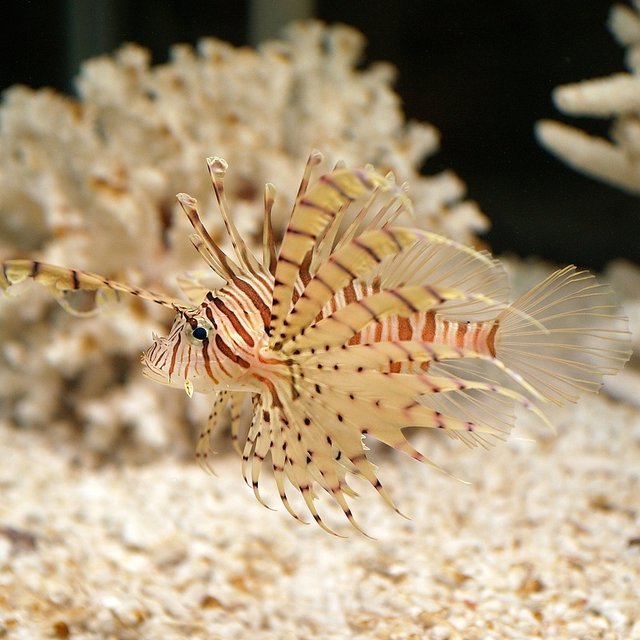Venomous Creatures #4 - Red Lionfish
Hello Steemians and Friends, welcome to another edition of the Venomous Creatures. Today we are going to be looking at our first aquatic/marine creature, ain't you excited? The name of this creature is known as Red Lionfish. Lionfish? Yea, smiles, I guess some of you guys are already thinking that, this creature is the King of the Ocean or the most venomous marine creature, because it bears a similar name like the King of the jungle, which is the Lion. Are your guesses right? Hmmm, you can find out as you read through(smiles).
In this article, we will be discussing about the necessary details you need to know about the Red Lionfish, such as their life cycle, their feeding nature and many more. I therefore suggest that you relax yourself and get thrilled with this article I made just for you(smiles).

[Source: Wikimedia Commons. Author: Jens Petersen. CC-BY-SA-2.5 Licensed.]
Red Lionfish - Pterois Volitans
The Red Lionfish are also known as Zebrafish, Scorpion-cod, butterfly cod, featherfins and Fire Fish. These creatures are the first Indo-Pacific marine fish to be able to create a permanent habitat in the Atlantic and Caribbean waters. They are mostly called Invasive Lionfish, reason being that, they were never a resident in the Atlantic waters but have now become one of the most popular predators in the Atlantic waters. These creatures were first discovered in Western Atlantic, Florida, in 1985 and since they to now, they have extended their range to the Caribbean coast of Mexico and also to Central and South America.. It's native range is the Indian Ocean and the Pacific Ocean. You can see the map of the Invasive Lionfish here for more understanding.
Scientific Classification - Kingdom: Animalia, Phylum: Chordata, Class: Actinopterygii, Order: Scorpaniformes, Family: Scorpaenidae, Genus: Pterois, Species: P. Volitans, Binomial name: Pterois Volitans (Linnaeus, 1758). Source
These creatures body are covered with red or golden brown or white bands stretching across their yellow background, and that is why some people call them Zebrafish. The reason behind the Turkeyfish name is because they have elaborate fan-like pectoral fins and long separated dorsal spines. The Red Lionfish can be differentiated from other species of lionfish as it has 13 venomous dorsal spines rather than 12 and 14 long feather-like pectoral rays. These creatures have a formidable defense body against it's predators. Apart from the 13 venomous dorsal spines they have, they also have 3 venomous spines at their anal fin and that is why there is still no known natural predators for these creatures.
These creatures are nocturnal in nature. They feed and remain out during the night, and as soon as the sun comes up, they go to their shadowy homes among the rocks and coral. I personally call these creatures Lonefish(from lone wolves, smiles), reason being that, as soon as they become adults they like staying by themselves and are very aggressive to any creature that comes into their territory, by using their venomous spines to defend their territory. They only come together to form a group of about 3 - 8, whenever they are about mating. The male Red Lionfish are more aggressive than the females but the females are larger in size than the males(again!!! if you are following my episodes you would understand). These creatures can grow to about a maximum length of 38 cm and maximum body weight of about 1.1 kg to 1.2 kg. Although when these creatures are juveniles, they live in groups.
Reproduction
As I said earlier, these creatures only come together to form a group when they are adults during mating. Their reproduction process is quite complex but very fascinating. These creatures are gonochoristic in nature i.e both the male and female shows sexual dimorphism only during mating i.e the male would become darker, their stripes would be less visible and they would be uniformly colored, while the female whose eggs are ripe would become paler, with many parts of her body becoming silvery white. The males would easily identify such females.
These creatures performs external fertilization of eggs. The male Red Lionfish always initiates the move just before dark. After the male has identified the female, the male would then circle the female several times and then the male would move up to the water surface with the female following the male as he goes up. When the female is following the male from behind, she tends to shake her pectoral fins as a sign of excitement. Both the male and female would move up and down several times before spawning i.e before the female releases her unfertilized eggs for the male to fertilize. These spawns (i.e unfertilized eggs) consists of two hollow mucus tubes and these two hollow mucus tubes contains about 2,000 - 15,000 eggs which would be floating just below the surface of the water as soon as the female releases her eggs, awaiting the fertilization of the eggs by the male. As soon as the two hollow mucus tubes reaches the surface of the water, the male would release his sperm into the two tubes for fertilization to take place. After the process of mating, both the male and the female would go their separate ways. Something you must know, the male Red Lionfish can become aggressive if disturbed during the mating and would aggressively attack any creature, even human with it's venomous spines. A quick advice of the recreational divers and fishermen, stay away from a male Red Lionfish when it's mating (smiles). Let's now move on to their feeding nature.
Feeding
Red Lionfish are voracious in nature, as an adult consumes about 14.6 g daily and juveniles consumes about 5.5 - 13.5 g daily. These creatures feeds on small fishes, shrimps, crabs and even invertebrates such as amphipods, isopods, and other crustaceans.
These creatures begins their feeding at sunset because this is when the coral reef activity is at the highest i.e all the day fish and invertebrates are heading to their various resting place while the night fish and invertebrates are just starting their day, so this much activity presents the Red Lionfish with so many varieties to choose from. With all the varieties of fish and invertebrates around at this time, the Red Lionfish needs not trouble itself, it simply just glide upwards along the rocks and coral and then stalks it's prey, by moving slowly towards it. Won't these creatures know of the Red Lionfish's presence, no, it won't. The Red Lionfish can easily camouflage in coral reef as it's color patterns would easily blend into the background of the coral branches, thereby preventing the prey from becoming alarmed.
The Red Lionfish are very fast when attacking it's prey. For instance, the Red Lionfish can quickly swallow a fish among a group of fish and the other fish in the group won't even notice what happened, that's how fast they can be. These creatures can also feed on it's prey by using their wide spread pectoral fins to trap it's prey into a corner and then swallow it. These creatures are cannibalistic in nature i.e they sometimes feed on their own juveniles, although it's not a common diet for the Red Lionfish. The Red Lionfish invest most of their energy in growing into a larger size during their early life, as these helps them to be able to defend themselves from predators and also to attack their prey easily. The male Red Lionfish can become very aggressive, when it's hunting and then meets another male hunting, the more aggressive male would become darker in color and would then point it's venomous dorsal fins at the other male, who would usually just swim away. As I said earlier, the Red Lionfish are voracious in nature, therefore when they become full, they do not eat for at least 24 hours. These creatures can also go as long as 12 weeks without food. Let's now move on to the life cycle of a Red Lionfish.

[The coral reef activity at dawn. Source: Pixabay. CCO Public Domain Licensed]
Life Cycle
Let's begin the Red Lionfish's life cycle from the point when the male fertilizes the two hollow mucus tubes. After fertilization has taken place, in about 12 hours, the embryo would already begin to develop. In about 6 hours after the embryo begins to develop, making it 18 hours after fertilization, the eyes and the head would have developed. After about 36 hours after fertilization, the larva would have hatched. After about 2 - 3 days, the already hatched larva has already become a very good swimmer. At the larval stage, the larva basically feeds on small ciliates and other small zooplankton. It takes the Red Lionfish about 25 - 40 days in the larval stage, after which they settle out of the water column, which makes them spread easily. It takes the Red Lionfish about 2 years to reach their sexual maturity and begin the process of reproduction all over again. The reason behind these creatures being invasive is that, each female Red Lionfish produces about two million eggs every year, which is very massive. The average life span of the Red Lionfish is 10 years.

[A Young Red Lionfish. Source: Wikimedia Commons. Author: Daiju Azuma. CC-BY-SA-2.5 Licensed]
Venom
The Red Lionfish is composed of acetylcholine and a neurotoxin which can cause cardiovascular and neuromuscular effects ranging from severe pain to swelling and in complicated cases paralysis. The venom of a Red Lionfish is not as dangerous as to cause death to humans but the effects could be excruciating and can last for days. These creatures mostly use their venomous spines to defend themselves and not to attack. They are not aggressive to humans, they do not just see humans and start attacking them. It is therefore advisable to keep your distance from them. The occasions in which humans get stung by these creatures are; during see diving, while hunting for these creatures, or while cleaning their aquarium tanks.
These creatures uses their dorsal spines to inject their venom into their victims and also causing wounds to their victims as they inject venom. The major symptoms of the Red Lionfish sting are; excruciating pain, swelling of the wound, heavy sweating, breathing difficulties, severe fatigue, rashes in the skin, reduced blood pressure and more. You must know that different people reacts differently to the Red Lionfish's venom. Some persons reaction may be severe and can lead to convulsion and paralysis. It is therefore, wise to stay away from these creatures. If you are stung or someone round you got stung by a Red Lionfish, you can easily treat sting by, first, removing the spine(s) of the Red Lionfish by gently pulling it/them out with a pair of tweezers, in cases where the spine(s) of the Red Lionfish remains with the victim. After doing that, put the wounded part of the body(usually the hand) into a hot water of about 45 degree celsius for 30 mins to an hour, as this would help reduce the pain intensity, because the Red Lionfish's venom is protein based, and can easily be neutralized by heat(hot water), hereby preventing the venom from moving into the blood stream. After all these, still make sure you visit the hospital for a proper check-up. According to Mike Ryan, an instructor at Horizon Divers in Key Largo;
It won't kill you, but it'll make you wish you were dead. Source
Threat
These creatures are not currently listed as endangered or threatened creatures under the IUCN Red List of Threatened Species. Instead efforts are being put to place to eradicate these creatures(smiles).
These creatures are invading the Atlantic and Caribbean waters in a massive way, spawning every four days and if you can recall each spawning results to about 2,000 - 15,000 eggs, making each female Red Lionfish capable of producing about two million eggs every year(Note: many of the eggs won't pass the larval stage). As a result of their rapid growth in population, these creatures are affecting the marine ecosystems. They are piscivorous in nature i.e they feed on fish, and since they have no known predator, the number of fish are decreasing in a massive way, which in turn disrupts the marine ecosystem. Some groups of recreational divers and fishermen are encouraged on killing these creatures in order to maintain balanced marine ecosystem. And also the demand of the Red Lionfish in restaurants is increasing, which have encouraged the fisherman and recreational divers to kill and sell these creatures and make a lot of profit because as demand increases, price also increases(smiles). I heard that these creatures are quite taste(yummy, winks).
Amazing Facts
- They are the first Indo-Pacific marine fish to be able to live successfully in the Atlantic and Caribbean waters.
- They are nocturnal in nature.
- Females are usually larger than the males.
- They are cannibalistic in nature.
- The females can produce about two million eggs every year.
I leave you guys with this amazing video by Coyote Peterson, Stung by a Lionfish, enjoy and if you want the Part 2, click here.
Till next time guys!!!
References
I'm a proud member of @air-clinic

I'm a proud member of @promo-mentors

I'm a proud member of @bigwaves

I'm a proud member of @stemng

I'm a proud member of @steemstem

)
)
.jpg](https://cdn.steemitimages.com/DQmZLka1w9ZNCny5Y2GEaSDQpwWJPLVy2CYvPXsMXEtxf6H/402px-Lionfish,_Belize_(4861694655).jpg))
great post. I dive a lot and have seen lionfish all over the world. They are an invasive species and are taking over everywhere. They don't have any real natural predators so they multiple quickly. Even still, they are very beautiful...
Yea, they are very beautiful.
Thanks for reading through @liquidtravel
Hi @menoski!
Your post was upvoted by utopian.io in cooperation with steemstem - supporting knowledge, innovation and technological advancement on the Steem Blockchain.
Contribute to Open Source with utopian.io
Learn how to contribute on our website and join the new open source economy.
Want to chat? Join the Utopian Community on Discord https://discord.gg/h52nFrV
Well researched, written, edited and proofread post. However, you should have put this in the required category on #air-clinic. Take care from next time onwards. Have a great day ahead.
Yea, I would.
Thanks for coming around @amarbir
Your Welcome. Remember your lesson and be a good boy. 😂😂
For real? Smiles
Yup.
Ok, my little boy, smiles